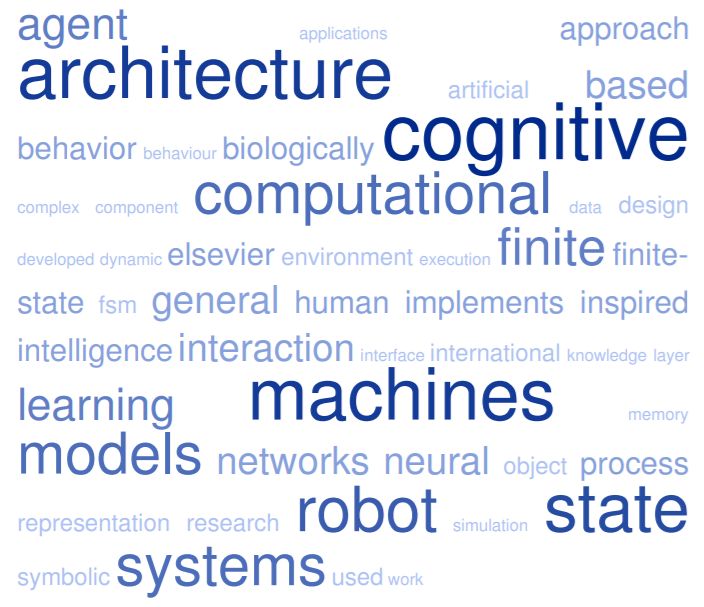
Notes:
A neural state machine (NSM) is a type of artificial intelligence (AI) system that uses neural networks to model and control the behavior of a system. It is based on the idea that the behavior of a system can be represented as a sequence of states, and that a neural network can be trained to predict the next state in the sequence based on the current state and other input information.
NSMs are related to cognitive architecture in that both are concerned with modeling and simulating the functions of the human mind. Cognitive architecture is a broad term that refers to a set of principles and theories about how the human mind works, and how it can be simulated or emulated using artificial intelligence techniques. NSMs are one approach to implementing a cognitive architecture, using neural networks to model and control the behavior of a system.
Wikipedia:
References:
- Learning by abstraction: The neural state machine (2019)
- Identifying Contemplative Intensity in Cognitive Architectures for Virtual-Agent Minds (2018)
- Integrating Cognitive Architectures into Virtual Character Design (2016)
- Just How Smart Are Smart Machines? (2016)
- Automation of robotic assembly processes on the basis of an architecture of human cognition (2011)
- Cognitive engineering of automated assembly processes (2011)
- First steps toward a cognitive architecture based on adaptive automata (2008)
See also:
100 Best Cognitive Architecture Videos | 100 Best MATLAB Stateflow Videos | 100 Best State Machine Videos | Cognitive Architecture & Dialog Systems 2018 | Cognitive Architecture & Virtual Humans 2018 | State Machine & Dialog Systems 2018
- Angleraud, A., Houbre, Q., Kyrki, V., & Others. (2018). Human-Robot Interactive Learning Architecture using Ontologies and Symbol Manipulation. 2018 27th IEEE …, IEEE.
- Bergman, M. K. (2018). Potential Uses in Depth. In A Knowledge Representation Practionary (pp. 117-136). Springer. doi:10.1007/978-3-319-97313-1_8
- Calzado, J., Lindsay, A., Chen, C., Samuels, G. (2018). UWS Academic Portal. Retrieved from https://myresearchspace.uws.ac.uk/ws/portalfiles/portal/30459502/Calzado_J_Conference_Proceedings.pdf
- Cao, H. L., Van de Perre, G., Kennedy, J., & Others. (2018). A personalized and platform-independent behavior control system for social robots in therapy: development and applications. Proceedings of the 2018 …, IEEE.
- Chandlee, J., Heinz, J. (2018). Strict locality and phonological maps. Linguistic Inquiry, 49(1), 119-131. doi:10.1162/ling_a_00251
- Evensen, P. I., Stien, H., Bentsen, D. H. (2018). Modeling human behaviour using behaviour trees. Retrieved from https://www.ffi.no/no/rapporter/2018/Modeling-human-behaviour-using-behaviour-trees
- Fischer, D., Mostaghim, S., & Albantakis, L. (2018). How swarm size during evolution impacts the behavior, generalizability, and brain complexity of animats performing a spatial navigation task. Proceedings of the Genetic and …, ACM.
- García, D. H., Adams, S., Rast, A., Wennekers, T., Lewis, M., Mann, G. K., & Roberts, D. (2018). Visual attention and object naming in humanoid robots using a bio-inspired spiking neural network. Robotics and Autonomous Systems, 103, 13-29. doi:10.1016/j.robot.2018.02.007
- Gonzalez-Rodriguez, D., Hernandez-Carrion, J. R., & Others. (2018). Self-Organized Linguistic Systems: From traditional AI to bottom-up generative processes. Futures, Elsevier.
- Iantovics, L., Dehmer, M., Emmert-Streib, F. (2018). MetrIntSimil—An accurate and robust metric for comparison of similarity in intelligence of any number of cooperative multiagent systems. Symmetry, 10(3), 59. doi:10.3390/sym10030059
- Iantovics, L., Dehmer, M., Emmert-Streib, F. (2018). Multidisciplinary and historical perspectives for developing intelligent and resource-efficient systems. IEEE Access, 6, 36918-36928. doi:10.1109/ACCESS.2018.2851930
- Ienca, M. (2018). Cognitive technology and human-machine interaction: The contribution of externalism to the theoretical foundations of machine and cyborg ethics. Annals of the University of Bucharest-Philosophy …, ceeol.com.
- Kotseruba, I., & Tsotsos, J. K. (2018). 40 years of cognitive architectures: core cognitive abilities and practical applications. Artificial Intelligence Review, 2018, Springer.
- Litvinski, O. (2018). Algorithmic opacity: a narrative revue. Retrieved from https://archipel.uqam.ca/13228/1/34103.pdf
- Meulenbelt, D. A. (2018). Sighted MicroPsi Agents in Minecraft: Object Recognition Using Neural Transfer Learning and Automated Dataset Collection. Retrieved from https://dspace.library.uu.nl/bitstream/handle/1874/372585/DA_Meulenbelt_MscThesis.pdf
- Mämmelä, A., Riekki, J., Kotelba, A., Anttonen, A. (2018). Engineering Computational Emotion-A Reference Model for Emotion in Artificial Systems. Retrieved from https://link.springer.com/book/10.1007%2F978-3-319-74370-0
- Mittal, S., Martín, J. L. R. (2018). Netcentric system of systems engineering with DEVS unified process. Retrieved from https://content.taylorfrancis.com/books/download?dac=C2017-0-46236-0&isbn=9781351043899&format=googlePreviewPdf
- Mitchell, J. P., Dean, M. E., Bruer, G. R., Plank, J. S. (2018). DANNA 2: Dynamic adaptive neural network arrays. In Proceedings of the Genetic and Evolutionary Computation Conference (pp. 1-8). Retrieved from https://dl.acm.org/doi/abs/10.1145/3205455.3205555
- Molina, M., Suarez-Fernandez, R. A., Sampedro, C. (2018). International Journal of Intelligent Computing and Cybernetics. Retrieved from https://www.researchgate.net/publication/326723374_International_Journal_of_Intelligent_Computing_and_Cybernetics
- Narang, S. (2018). Simulating Plausible Movement-based Interactions Between Agents and Avatars Using Biomechanical Principles and Psychological Factors. Retrieved from https://search.proquest.com/openview/0b968577
- Perera, I., Allen, J., Teng, C. M., Galescu, L. (2018). A Situated Dialogue System for Learning Structural Concepts in Blocks World. In Proceedings of the 19th Annual Conference of the North American Chapter of the Association for Computational Linguistics: Human Language Technologies (pp. 170-180). Retrieved from https://www.aclweb.org/anthology/N18-1018/
- Rodríguez-Lera, F. J., Matellán-Olivera, V., & Others. (2018). HiMoP: a three-component architecture to create more human-acceptable social-assistive robots. Cognitive …, Springer.
- Sakuma, T., Miura, S., Miyashita, T., & Others. (2018). Development of Driving Intention Prediction System Based on Human Cognitive Mechanism. Proceedings of the 2018 IEEE …, IEEE.
- Santos, D., Palar, P., Oliveira, A., Fabro, J., & Others. (2018). Adding Conscious Aspects and Simulated Emotions through Facial Expressions in Virtual Robot Navigation with Baars-Franklins Cognitive Architecture. 2018 Latin American …, IEEE.
- Seidel, S., & Borghoff, U. M. (2018). Extracting State Machines from Feedforward Neural Networks